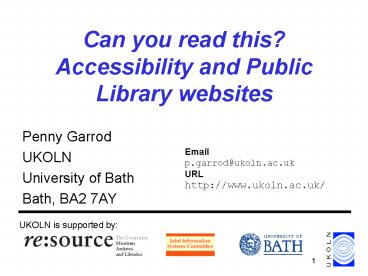Can you read this? Accessibility and Public Library websites - PowerPoint PPT Presentation
Title:
Can you read this? Accessibility and Public Library websites
Description:
1. Can you read this? Accessibility and Public Library websites ... local populations (ICT skills=jobs) engagement in local/national ... University, USA ' ... – PowerPoint PPT presentation
Number of Views:69
Avg rating:3.0/5.0
Title: Can you read this? Accessibility and Public Library websites
1
Can you read this? Accessibility and Public
Library websites
- Penny Garrod
- UKOLN
- University of Bath
- Bath, BA2 7AY
Email p.garrod_at_ukoln.ac.uk URL http//www.ukoln.ac
.uk/
UKOLN is supported by
2
Contents
- brief introduction to UKOLN
- the Public library agenda
- - Lifelong Learning ICT skills social
inclusion UKonline centres digitisation
projects - accessibility and usability why they matter
- compliance with standards
- - tools to gauge web site accessibility
- survey findings
- conclusions
3
UKOLN
- national focus of expertise in digital
information management - based at the University of Bath
- funded by JISC (HE and FE sector) and Resource
The Council for Museums, Archives and Libraries,
together with project funding (e.g. EU and JISC) - around 27 staff
- carries out applied research (e.g. in metadata),
software development and provides policy and
advisory services
4
Public Library Networking Focus
- My role
- to contribute to strategic, policy-making,
awareness-raising and development activities in
the area of public library networking and
lifelong learning.
5
Background - connecting up Public Libraries
CALL- Community Access to Lifelong Learning
Programme NOF funding - 230 million
Peoples Network Programme ICT infrastructure-
managed by Resource NOF funding - 100 million
NOF staff training Programme 20 million
NOF Digitise Programme 50 million
Bill Melissa Gates donation 4 million
6
Why Public Libraries
- 2005 - Governments commitment to get all UK
citizens online - Peoples Network all public libraries to have
Internet ICT learning facilities by end of 2002
70 now online - Social inclusion and learning agendas
- PLs now street corner universities UKonline
and Learndirect centresaccess to national
resources Community Grids for Learning - e-Citizenship e-local government
- empower local populations (ICT skillsjobs)
- engagement in local/national politics
- www.peoplesnetwork.gov.uk
7
Web accessibility a brief overview
- the Web was designed as a visual medium
- the Web is a democratising medium
- the web is about content and accessing that
content using technology - therefore - 1. the technology must be accessible
- e.g. hardware Operating Systems descriptive
URIs Uniform Resource Identifiers (URIs, aka
URLs) browsers adaptive technologies
connection speeds (uploading and downloading)
etc. - the content must be accessible
- e.g. easy to navigate well-structured concise
easy to understand easy to locate using search
engines Universal Design adhere to standards
8
The case for Universal Design
- RNIB states that accessibility should be
incorporated into design brief (as requirement)
when tendering for website development - Georgia State University, USA
- We are currently building a new economy, a new
government, a new society that is based around
the Internet. How ironic it would be if the
foundation stones don't include accessibility,
and then when we need it in our old age -- we
can't access it? The access you ensure today may
be your own, tomorrow! - http//www.gsu.edu/wwwdls/show_case/Presentations
/universal_design.html
9
APLAWS initiative
- Accessible Personalised Local Authority
Websites - London-based consortium of councils
- To develop a content management system to
standardise the way content is laid out and
navigated on council web sites - Pathfinder project working towards all services
online by 2005 - http//www.aplaws.org.uk
10
(No Transcript)
11
Accessibility standards and guidelines. Is
there a consensus?
- Use W3C WAI (Web Accessibility Initiative)
Guidelines http//www.w3.org/TR/WAI-WEBCONTENT/ - Use HTML validation service http//validator.w3.o
rg/ - Aim for Universal Design or design for all
- Aim for W3C Double A conformance aim to meet
Priority One and Two guidelines for accessibility - Use Bobby for automated checking of pages
12
(No Transcript)
13
Best Practice manual www.nlbuk.org
14
Web-based tools the WAVE
- Pennsylvanias Initiative on Assistive Technology
from - http//www.temple.edu/inst_disabilities/piat/wave
- cannot tell you if page is accessible - no tool
can - adds icons and text to help you judge if page is
accessible provides information to help you
exercise judgment - downloadable tutorial
- Incorporates browser check e.g.
- I'm using a recent browser (Internet Explorer
5, Navigator 6, Opera 4 or higher) - Analyze No-Frame Version
- Downloadable Wave button (like Google)
15
(No Transcript)
16
(No Transcript)
17
Web-based tools Bobby
- from http//www.cast.org/bobby/
- Offers choice of guidelines
- Web Content Accessibility Guidelines
- from the Web Accessibility Initiative (WAI)
World Wide Web Consortium ( W3C) - Section 508 guidelines developed by the U.S.
Federal Government. - Select the WAI/W3C guidelines
18
(No Transcript)
19
www.ukonline.gov.uk
20
www.ukonline.gov.uk - normal view
21
Easy access version of UKonline
22
Results of recent UKOLN benchmarking survey
- Bobby (accessibility compliance)
- undertaken on 23 April 2002 by Brian Kelly, UKOLN
Web Focus - sample taken from SPIN SOCITM Website awards,
2001 - 18 Local Authority entry level pages analysed for
accessibility (5 x England 5 x Scotland 4 x
Wales 4 x N. Ireland) - Priority 1 (P1) errors one site had NONE two
sites had 5 P1 errors one had 6 P1 errors - Priority 2 (P2) errors ranged from 1 - 4 errors
average P2 errors 2.4 - See http//www.ukoln.ac.auk/web-focus/events/conf
erences/spin-2002/
23
Guidelines and resources
- Techdis http//www.techdis.ac.uk/ for HE
community but useful stuff e.g. - How People with disabilities use the web
- http//www.w3.org/WAI/EO/Drafts/PWD-Use-Web/Overvi
ew.html - RNIB guidelines See it right campaign
- NLB website http//www.nlbuk.org/
- Best practice manual
- Jakob Nielsen (2000) Designing Web usability
the practice of simplicity. Indianapolis, Ind.
New Riders. - Lynx view www.delorie.com/web/lynxview.html
24
(No Transcript)
25
IDeA website viewed through Lynxviewer
26
Any questions?
'image www.freeimages.co.uk'































